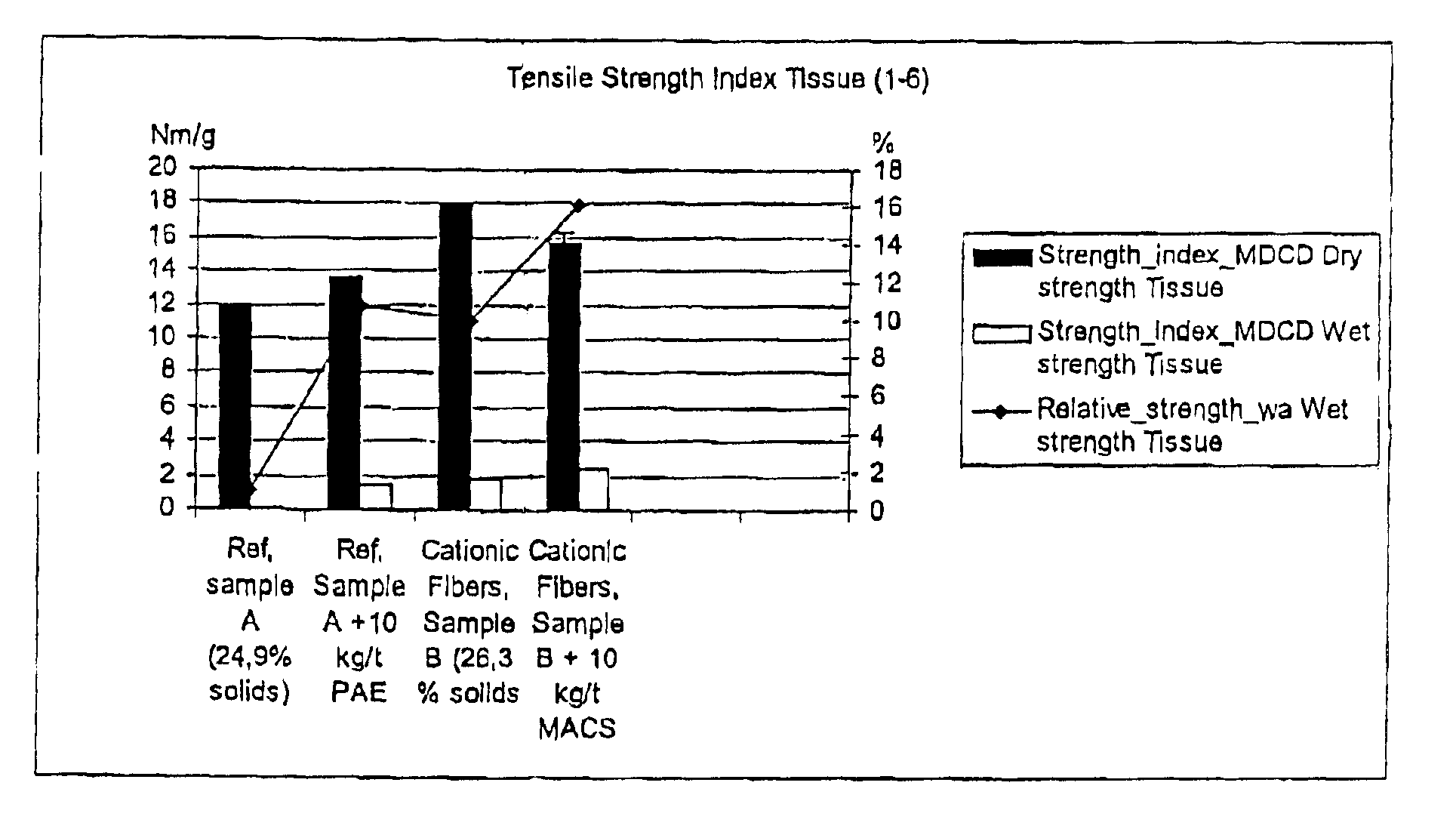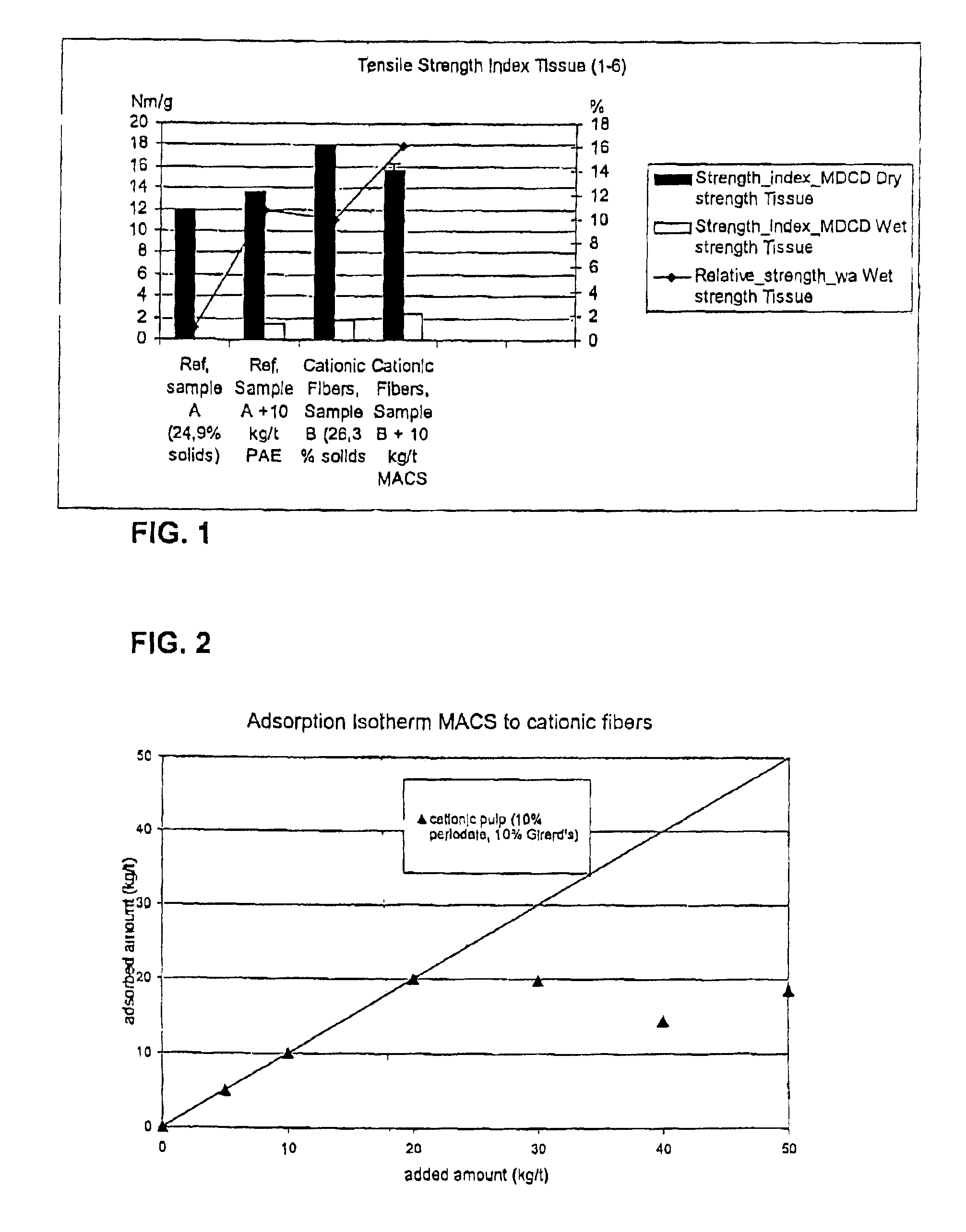Cationic fibers
a technology of cationic fibers and cationic fibers, applied in the field of cationic fibers, can solve the problems of poor biodegradability, pressure on pae use, and move away from oil-based chemicals, and achieve the effect of enhancing the binding power of the fibre and introducing additional functionality into the fibr
- Summary
- Abstract
- Description
- Claims
- Application Information
AI Technical Summary
Benefits of technology
Problems solved by technology
Method used
Image
Examples
example 1
Production of Cationic Fibres and Sheets
60 g pulp (sulphate pulp, TCF, SCA Östrand mill, 370 mmol) was disintegrated and suspended in 6 1 water. Sodium periodate (7.9 g, 37 mmol) was added and the mixture was stirred for 6 days in the dark at pH 5. Then, the sodium iodate was removed by washing the fibres with water. Subsequently, the fibres were resuspended in 2 1 water, Girard's reagent T (trimethylammonioacethydrazide chloride) was added (6.2 g, 37 mmol) and the mixture was stirred for 2 hours at 40° C. The fibres were washed and dewatered as much as possible. The presence of aldehydes in the fibres was shown by reaction with hydroxyl-amine hydrochloride and subsequent release of hydrochloric acid, and the cationic nature was confirmed by the adsorption of polyethylene sodium sulphorate and of MACS (adsorption was followed by polyelectrolyte titration of the supernatant solution containing the anionic polymers).
The cationic fibres were used to make lab sheets (Rapid Köthen). As r...
example 2
Absorption of Anionic Wet Strength Agent onto Cationic Fibre
Cationic fibres were prepared as described in Example 1. Suspensions of these fibres (100 ml, 1.5% consistency, pH 6.5) were mixed with different amounts of a 1% solution of monoaldehyde carboxy starch (MACS, produced as described in WO 01 / 83887). The addition levels were 5-50 kg / t and the contact time was 5 minutes. The fibres were filtered through a glass filter and dewatered as much as possible. The non-adsorbed MACS was measured in the filtrate using TOC (total organic carbon analysis). From the values obtained the adsorbed amounts were calculated. The results are shown in the adsorption isotherm shown in FIG. 2. It is shown that 20 kg / t MACS can be adsorbed to the cationic fibres, whereas it was shown that less than 1 kg / t MACS can be absorbed by unmodified fibres (see WO 01 / 83887).
example 3
Coupling of6-Carboxyβ-Cyclodextrin to Cationic Fibres
6-Carboxy β-cyclodextrin was prepared by oxidation with 4-acetamido-TEMPO and hypochlorite. Thus, 7.64 g β-cyclodextrin, 150 mg NaBr and 150 mg 4-acetamido-TEMPO in 300 ml water. Sodium hypochlorite was added in doses of 0.20 ml per time. After each dose the reaction was allowed to proceed until no further NaOH consumption was seen. During reaction the pH was kept at 9.3 by addition of NaOH controlled by a pH stat. Two samples were prepared with a degree of oxidation of 0.11 and 0.38, respectively.
Cationic fibres were prepared by oxidation of sulphate pulp fibres (SCA Östrand mill) with sodium periodate (DO=10%) and the obtained aldehyde groups were subsequently reacted with Girard's reagent T (acethydrazide trimethylammonium chloride). Hereby fibres containing 10% cationic groups were obtained.
Next 30 mg of 6-carboxy β-cyclodextrin (acidic form) was dissolved in 5 ml demineralized water and added to 1g (dry weight) of cationic fi...
PUM
| Property | Measurement | Unit |
|---|---|---|
| temperature | aaaaa | aaaaa |
| temperature | aaaaa | aaaaa |
| temperature | aaaaa | aaaaa |
Abstract
Description
Claims
Application Information
 Login to view more
Login to view more - R&D Engineer
- R&D Manager
- IP Professional
- Industry Leading Data Capabilities
- Powerful AI technology
- Patent DNA Extraction
Browse by: Latest US Patents, China's latest patents, Technical Efficacy Thesaurus, Application Domain, Technology Topic.
© 2024 PatSnap. All rights reserved.Legal|Privacy policy|Modern Slavery Act Transparency Statement|Sitemap


